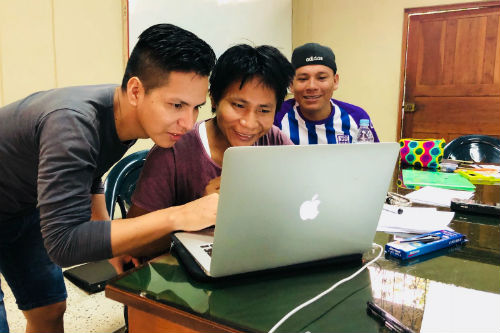The project called Amazonimations is funded by the British Academy. Its aim was to co-produce animated films with different generations of Matses who have only established contact with mainstream society in recent years.
The Matses live in the Peruvian and Brazilian Amazon. Their ancestral lands are currently being encroached by illegal logging practices and poaching.
Dr Camilla Morelli, from Bristol’s Department of Anthropology and Archaeology, is the project’s academic lead and has been working with the Matses, specifically children and young people, for the past ten years.
She said: “Like many indigenous and rural societies across the world, the Matses people are feeling the effects of growing challenges such as economic hardship and environmental change. Added to this is the crucial and troubling fact that they feel as if the world doesn’t know who they are or that they even exist.
“The process of co-producing animation was a medium to engage them actively in the research process, while also opening up a platform for them to discuss their lives and the challenges they face and tell a story to the wider world.”
The team produced three animations. The stories were entirely written and narrated by the Matses and illustrated by the children and lead artist and illustrator, Guillermo Pemen, who is himself Matses.
The films were animated and mentored by Sophie Marsh, a professional animator who has worked for Cannels 4 and Aardman Animations in Bristol.
The first film was produced by older members of the group and describes a traditional ritual that has been practised by the Matses for generations, the application of an intoxicating secretion produced by a frog onto a person’s burnt skin.
The poison is not hallucinogenic, but elderly people say it makes you strong and it gives ‘sinan’ a kind of spiritual energy that connects the world of humans with that of the forest. They were keen to use this as a theme for their film as they see this ritual as a key part of their culture which is no longer so relevant for the younger generation.
The team worked with Matses children on the second film which focusses on the kinds of animals that live in the rainforest and shows how they talk about them using different categories of classification compared to western understandings (for example, monkeys are “food” and dolphins are “spirits”).
And, the final film tells the story of young Matses adults who leave the forest to find a new life in the city with all the challenges and rewards such a big step inevitably brings.
Dr Morelli added: “The overall goal is to use collaborative animation as a medium through which marginalised communities can use digital technologies that they have limited access to and gain a sense of inclusion by telling their own stories to the world. We have been teaching basic illustration and animation techniques to young people with the hope that one day they will be able to produce animated films by themselves.
“The aim now is to share the animations as widely as possible in order to raise awareness about the Matses and their culture across the world. The films have already been shown in film festivals, but we want to publish them now to reach the overall goal of making the Matses known to a wide public.
“The Matses have the animation files, which they watch on smartphones that most people own - and charge using small solar panels in the rainforest, and they will share the animations amongst them via Bluetooth.
“We are now working together to apply for funding to produce more animations, because they really loved the project and want to make more. We have also been contacted by two different indigenous groups in Peru who asked us to produce films and teach animation to their children as well, so we are working to make this happen.”
AMAZONIMATIONS submission video from Amazonimations on Vimeo.

